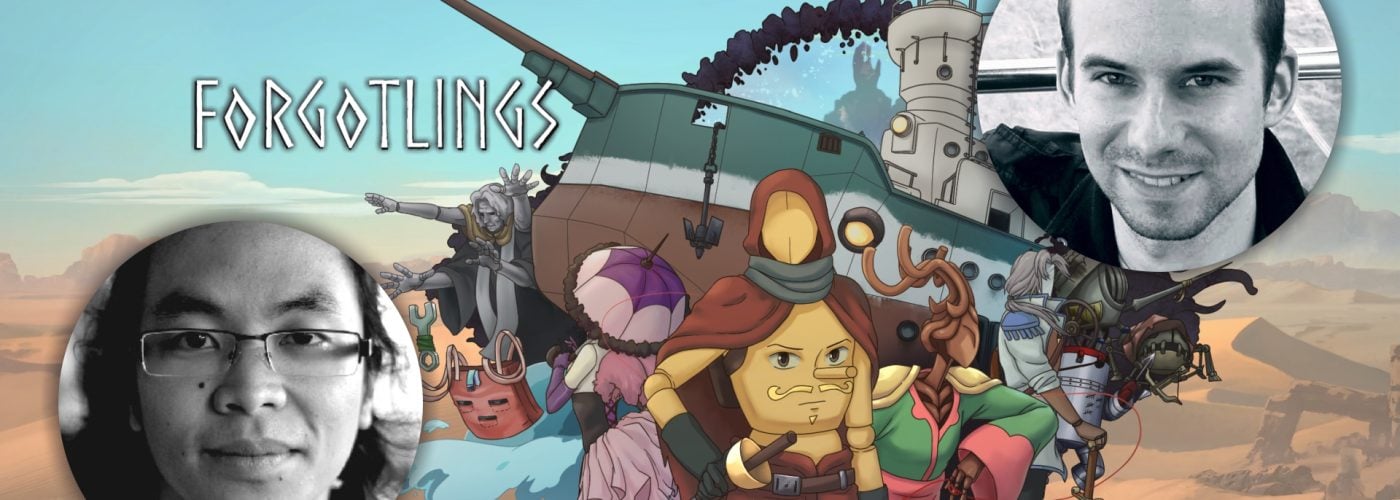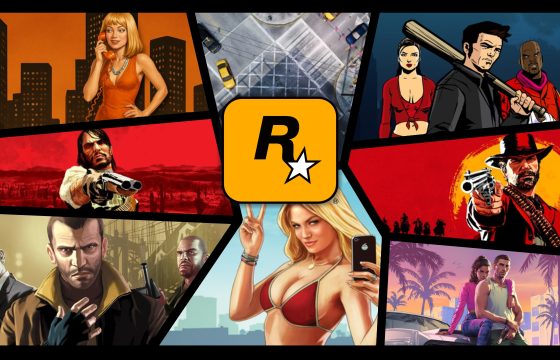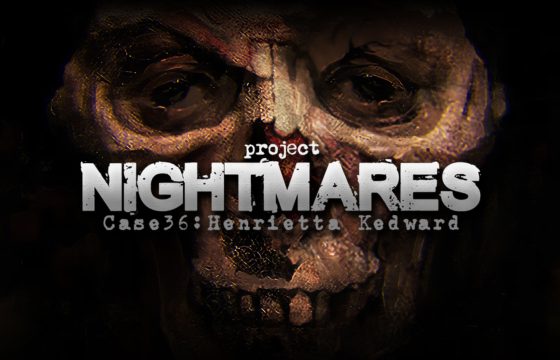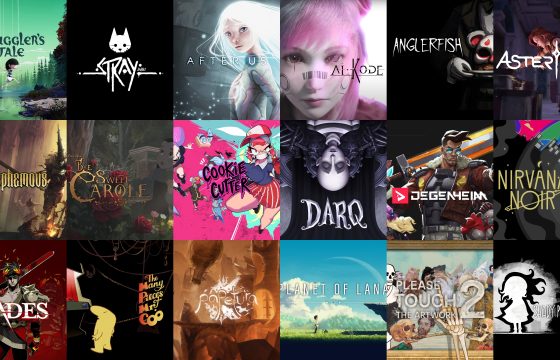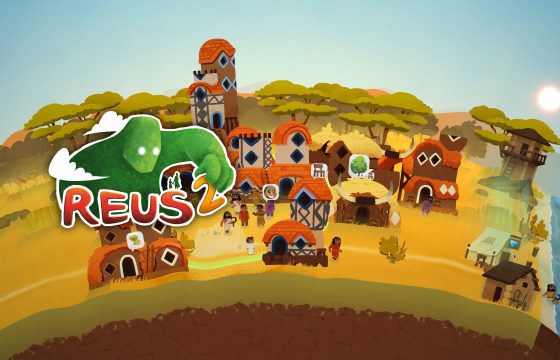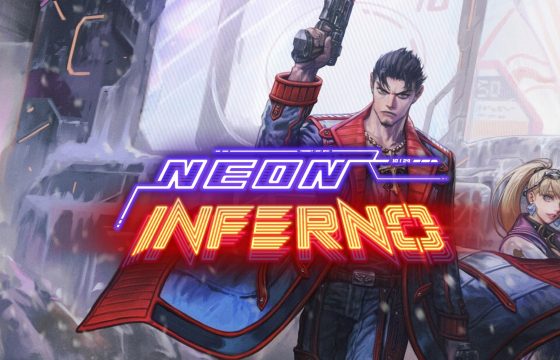Discover the soul and magic of the Forgotten Lands through the voices and creative vision of its two masterful architects: Creative Director Alfred Nguyen and Technical Director Michael Godlowski-Maryniak.
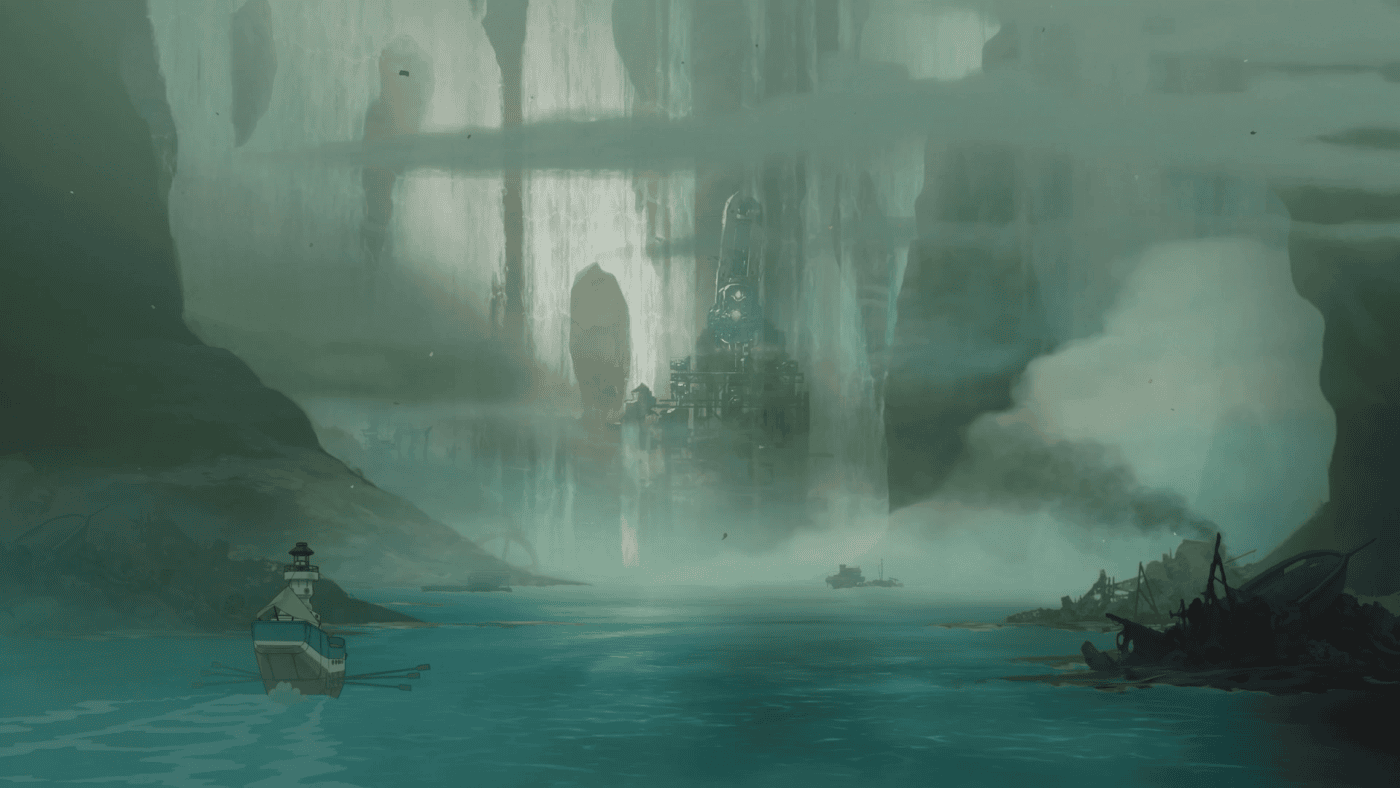
There are creative projects that, for the longest time, drift quietly beneath the surface—like soft whispers carried on a gentle breeze under a vast, star-studded night sky. Yet, hidden within that serene calm lies a fierce, glowing heart—an untamed spark of brilliance and promise, like a meteor blazing silently through the cosmos. When such a project finally draws near, it doesn’t just appear—it announces itself with quiet, irresistible force, leaving a mark that lingers deep in the soul. This is exactly the feeling that washed over us when Forgotlings first crossed our path— the second installment in the cinematic adventure series set in the Forgotten Lands, and the poignant prequel to Forgotton Anne.
In an industry too often ruled by profit over passion, by cold analytics instead of artistry, and by the relentless chase for quantity over the devotion to quality, Forgotlings shines like a rare and brilliant gem. It masterfully weaves bold creativity, a unique artistic sensitivity, and an unmistakable visual identity into a traditional gameplay framework—breathing fresh, rich, and captivating life into a narrative already brimming with meaning and heart. It has soul. It has identity. Like a true meteor, it emerges quietly among us, much like Forgotton Anne did before it, without fanfare or grand announcements. It is this subtle power—this gentle but unyielding light—that inspired us to tell its story.
This deep dive was born from that very impulse—a heartfelt desire to give voice to the extraordinary talents behind the Danish studio Throughline Games, to share their creative vision, and to introduce their work to as many passionate lovers of the medium as possible. Of course, we couldn’t tell this story alone. That’s why we reached out to those who know this project best—whom we warmly thank for joining us today: the two distinct yet perfectly complementary minds behind Throughline Games, Creative Director Alfred Nguyen and Technical Director Michael Godlowski-Maryniak.
So, with introductions behind us and anticipation in the air, it’s time to embark on this journey. Step aboard Volare, the majestic vessel that carries the Forgotlings, and join us as we set sail toward the very heart of today’s interview and deep dive—into the bewitching and enigmatic Forgotten Lands.
The Interview
Hello Alfred, hello Michael, and a warm welcome to both of you. We’re thrilled to have you with us for this special deep dive into Forgotlings. To start, and to help our readers gain a deeper understanding of who you are, we’d love to hear about your individual and shared artistic and professional journeys. Could you walk us through the key milestones of your respective careers and explain how your paths converged, ultimately leading to the founding of Throughline Games nearly 11 years ago? We’re eager to learn more about you both, not only as individuals and artists, but also to gain insight into the creative and professional experiences that have shaped—and continue to shape—your work today.
Michael: Thank you for the warm welcome!
Alfred: We’re also both very excited to join you at Indie Games Devel for this special interview.
Michael: I will start with sharing a bit about my journey. When I finished my game studies at the IT-University of Copenhagen, it was during the time when mobile apps were really starting to boom. Like so many others I was caught in the excitement of the seemingly endless possibilities. During this time, I took on almost any challenge—whether it was a game or a utility app—to hone my skills and hopefully create the next breakthrough. Although this was an exciting period, I always had a longing inside to create something on a grander scale. Since childhood, I have been drawn into the vast universe of games, anime and movies, and their ability to tell stories that can make me think and feel deeply. So I wanted to create something of equal scale. This is of course not a small endeavor, and luckily I met Alfred who shared a similar dream.
Alfred: While Michael was studying games, I was at The National Filmschool of Denmark to become a director specializing in animation. It was through that programme that I got my first hands-on experience with making games. I graduated with a short film, and then travelled the festival circuit and won a few awards. But for some time afterwards, I struggled to get my own film projects financed. I took on a range of freelance jobs as art director, compositor, photographer—virtually any visual design position where I could contribute with my skills. A friend then introduced me to a creative director position at a mobile games studio. The few years I spent there and the successes of a few casual titles really prepared me for the challenge of starting my own game studio. With casual mobile games having such a quick turn-around development time, I longed deeply to return to my roots of storytelling and visual craftsmanship.
Eventually our paths converged, as Michael and I met while both working at the same game studio and only really hooked up when we both had quit for different reasons. It was definitely at first a shared love for story-driven games and wanting to pursue game development on our own terms. Our personal aspirations aligned as Michael had always wanted to create things on a grander scale, like those vast worlds that had inspired him during childhood, and I longed to return to my storytelling roots. That led to the founding of our studio Throughline Games, with Michael as Technical Director and myself as Creative Director.
There is a well-known and thought-provoking quote by the renowned Italian author and aphorist Fabrizio Caramagna: “Sometimes we take paths that the heart cannot understand and the mind cannot explain. But the soul knows.” Focusing on the latter part of this reflection, would you say that your very first meeting — which ultimately led to the founding of your game studio — was an instinctive, almost serendipitous connection, guided by your most genuine creative impulses, as though an invisible thread linked two kindred spirits on the same wavelength? Or was it instead a more intentional and deliberate process, one that brought together two distinct artistic visions and perspectives, consciously woven into a single, cohesive creative identity?
Alfred: I love your poetic descriptions and I could subscribe to it upon reflection. As I mentioned earlier, though Michael and I worked at the same game studio, we began to really connect with each other only afterwards, when we’d both left for our own separate reasons. It was the love for story-driven games that we shared, along with the desire to develop projects on a grander scale on our own terms. The funny thing is, since we partnered up we have discovered more and more links or “invisible threads” connecting us, as you would say. We both attended the same primary school and while I was the senior, we had some common friends during childhood without ever knowing about one another.
Michael: Indeed, it’s like those plot twists you often see in anime or JRPGs. I also love this question not only because it gives me anime vibes, but also because it reminds me of my own reflections in many aspects of life.
Alfred: I think we have different temperaments and approaches but ultimately share the same vision, and so complement each other well as a founding pair.
Now that we’ve discussed the foundational steps that led to the creation of Throughline Games, let’s shift our focus to the more recent years, just before the release of your debut game. Could you walk us through the initial steps Throughline took to establish its foothold in the industry, how the studio has evolved since its inception, and what the current structure and composition of your team are like?
Alfred: We started Throughline Games in 2014, which is eleven years ago now. Eleven years feels like a century in the gaming industry because things are evolving so quickly and development is so eventful. Despite some previous experience, I think we’ve gone from being quite wide-eyed to—shall we say—not shying away from being described as veterans.
There are always things to learn, but we are approaching things in a more calm manner. When starting out, everything all the time was “all or nothing”. Without a family to care for we could dedicate ourselves 110% to making things work. But fast forward and I’m a father of two now with ‘adult life’ responsibilities and so perhaps a more nuanced or balanced view of things has taken hold. We’ve gone from embracing crunch to not relying on it.
The team size varies depending on the stage of development, but typically it ranges from six to twelve people. We make games for the process as much as the result and so collaborations are important for us. Most of the people on our projects are the same, or have been discovered through internships and close networks rather than job postings. We like a good connection between team members, and also a good connection between members and the project.
Our team composition and structure is like an onion. We are a team of four at its innermost core. Then the next layer involves a number of individuals we usually employ as the first ones when development begins, and the subsequent layer includes people whom we usually draw upon at different stages of development. We like to offer some stability and retention, but in this day and age it is a difficult thing to do.
Michael: Thinking back to the early days, I remember them as quite a wild ride. The initial concept of our first game Forgotton Anne had a different vibe compared to the final product, and getting to that point was truly an iterative process filled with numerous demos and imaginative ideas. We even embarked on a small adventure to Montreal, Canada, for a three-month company accelerator program, which helped us mature as a company and provided some wonderful networking opportunities. During that time, Forgotton Anne also underwent significant changes, including the removal of a main character—one who hasn’t been completely forgotten, as they will make a special appearance in our upcoming game Forgotlings.
Reflecting on Alfred’s onion analogy, it’s a bittersweet experience. On one hand, we have the privilege of meeting many amazing and talented people. On the other hand, our time working together is often limited to a project. One of our dreams for the future is definitely to grow our core team.

The studio’s name sprang from the narrative concept of a through-line: the central idea that runs from the beginning to the end of a story.” If we had to identify the very first thing that struck us—like an arrow straight to the heart—when visiting your website, it would undoubtedly be this phrase. It’s concise, evocative, and profoundly resonant. More than just a tagline, it encapsulates your entire brand identity: from the studio’s name to the composition, form, and color palette of your logo. But more importantly, it reflects the very core of your creative philosophy. Could you delve deeper into the significance of this concept? What does it mean to you, and how does this narrative-driven vision shape and guide your approach to storytelling and game development as a whole?
Alfred: Firstly I have to say that our games are a huge team effort and collaborative process. But I believe that within Throughline, the creative leads, in particular, should always have a deep and personal connection with a project in development. While details change, the themes of each project we undertake remain the same from inception to release. It’s the throughline and it comes from a personal place which ensures our work remains relevant to ourselves and our passion is retained throughout, however long a development process takes. Each teammate, while having a different background and personality, might still be able to tap into a theme but from a different perspective.
As we get deeper into discussion about both Forgotton Anne and Forgotlings, I’ll be sure to delve further into the specific throughlines and themes that have manifested in both games, as well as how they came about. That includes the themes of “neglect” & “cycles” for Forgotton Anne, as well as the throughlines of “purpose”, “multiplicity” and “unity” in Forgotlings.
Michael: As you mention with the style of the website and our logo, the idea was to make it resemble something handcrafted. As our world moves forward and becomes optimized at an astonishing pace, it’s important to have something grounding—something with a human touch—to remind us where we come from and prevent us from getting lost in the turmoil. I believe this is reflected both in the stories we want to tell and in our company culture.
Art and narrative are arguably two of the core pillars that define both your creative philosophy and your approach to game development. At the core of your work lies the ambition not merely to produce something for players to passively consume, but to craft deeply immersive, narrative-driven experiences grounded in a strong artistic vision. With that in mind, we’d love to delve deeper into your creative vision: what is the initial spark in your creative process—the element that first takes shape and sets the entire project in motion? Is it the narrative, the visual art, or perhaps an entirely different inspiration?
Alfred: Thank you for the recognition. I think it happens on an unconscious level and builds up over time—before crystallizing in an image, or becoming like a short clip playing in the mind. It contains a number of elements eventually becoming what you call the “spark” that sets things in motion.
Michael: I think Alfred describes it quite well. Sometimes, it is something we have carried with us for a long time without always realizing it was there. It can be a story or a message we want to share with the world. Eventually, images begin to form in the mind due to some external stimulus, requiring an outlet. This then becomes the initial concept or contributes additional ideas to an already existing one.
Alfred: With Forgotton Anne, my wife and I were watching a classic TV show, Anne of Green Gables, while I was in a period of contemplating on what kind of game project to embark on independently after just quitting my job. One night, I had a dream about a girl in an impressionistic setting opening and closing doors in a beautiful surreal labyrinthine maze of sorts. The next day I began drawing and sketching a mockup of a dark fantasy game poster titled, “Impressive Anne”.
From there it was just about clarifying themes I’ve been carrying with me and continuing to develop ideas that naturally occurred from there on. When more and more people become involved, more ideas come to the table and we’re able to tighten the vision. It’s like knowing your motif, but through collaboration, we choose an angle, pose, lens, then set up the lighting and adjust the settings to take that final “picture”.


Before we delve into the heart of Forgotlings, we’d like to take a brief step back and focus on your home country—Denmark—to reflect on the state of its video game industry and how it is perceived and supported. How would you describe the current state of the Danish gaming scene? How has it evolved over the years, and what is the general perception of the industry—both from public institutions and from the broader public opinion? With renowned studios like Playdead, IO Interactive, and Ghost Ship Games—alongside your own Throughline Games—Denmark is clearly fostering a thriving and increasingly influential game development ecosystem. Within this landscape, what role do you see Throughline Games playing? How much do you feel you’ve already contributed—and what more do you hope to bring—to the ongoing growth and international recognition of the Danish game development industry?
Alfred: Denmark has a great environment for making games. I’m thinking about its generous welfare system, great infrastructure, relatively low economic inequality, lack of natural disasters and high trust in society. On the other hand, it’s an expensive place to live and work, and there are limited funding sources for games. We’ve had a few big players in the past and just recently a separate game institute has been formed—separate from The Danish Film Institute, which previously was the place to apply for government grants for developers. While we are flattered to be mentioned in the same breath as the other studios you mention, we identify more with the struggling indies—with the business side of things never having been our core competence. That said, we enjoy being able to be first-movers with some aspects of our games and being able to inspire a local community—more as a side-effect of pursuing our passions as artists than intentional ambition.
Michael: I have often thought of the games industry here as a kind of big family. Since Denmark is a small country, people tend to know each other quite well, as we often attend the same gatherings and events. The overall vibe is generally more supportive than competitive. Additionally, when traveling abroad to conferences and similar events, it is quite common to bump into someone we know and offer each other help.
It was also here in Copenhagen that the creation of the Unity game engine began. I remember many years ago when some members of the Unity team visited different classrooms at my university, advertising their relatively young engine and encouraging us to try it out for our game jam projects. Needless to say, much has happened since then, and we have, of course, been using Unity for both Forgotton Anne and Forgotlings. The engine feels like a part of our local community as well.
Forgotton Anne was your first original IP, a project that immediately showcased who you are, your talent, and revealed your unique approach to game development. However, let’s rewind a bit further—before the initial concept even took shape. What is the true story behind Forgotton Anne? What was the defining moment that shifted the project from a standalone production into what would become the foundation for a full-fledged series? Why Forgotton Anne specifically? What motivated that decision, and, perhaps most significantly, what personal meaning does Forgotton Anne hold for you?
Alfred: Forgotton Anne has threads to my roots and upbringing, as well as the crossroad I was facing in my adult life at thirty years of age. The premise of remembering something important, of delving into the “forgotten,” related to my life situation where I was making casual games with little story, which was very far away from what had animated me throughout my life. So I needed to soul-search and see how I could tap into what I had abandoned inside of me. Everyone will be able to tap into parts of themselves they have forgotten.
On the other hand, my roots—being a child of refugee parents fleeing an authoritarian regime—also shaped me. It was not always in a manner that encouraged my artistic inclinations, and so there was an element of breaking free from cycles that led to an aesthetic and thematic layer in the story. Once you identify a theme—in this case I went with the word “neglect”—you see patterns and subthemes reflected in the broader world. One instance from early development that inspired a shot in Forgotton Anne was experiencing a homeless man lying in the middle of the pavement in almost a foetal position, in a busy street with people walking by and walking around him, barely noticing him. At that moment, it felt like the theme found its anchor in the premise of the game: A circle of neglect, with modern consumerism affecting our relations with each other leading to us forgetting our humanity, treating each other as things we consume and being judged by our usefulness. As Anne, could you break free of this circle?

Forgotton Anne was, despite its relatively brief length, a uniquely memorable experience. Its emotional depth and pathos, amplified by the seamless blend of exceptional sound design, distinctive art direction, and a meticulously crafted gameplay formula, turned it into a deeply personal journey. When a game resonates so powerfully, there’s always a lingering concern that a new installment—whether a prequel or sequel—might fail to capture the same magic, or to evoke the same emotions and experiences that made the original so impactful. However, this did not seem to deter you. On the contrary, it appears to have inspired you to push beyond previous boundaries and further refine what you had accomplished. So, our question is: why? Did you feel there was more of the story to tell, that it deserved additional chapters? And, perhaps most importantly, what led you to choose a prequel to Forgotton Anne?
Alfred: If Forgotton Anne was a portrait picture, Forgotlings is the wide-angled epic landscape picture. We had a lot of ideas when developing Forgotton Anne that needed to be scrapped in order to focus on the essentials, and so with Forgotlings we allowed ourselves to work on a bigger canvas that could contain a larger story and world.
Naturally as an indie, we might have to paint with broader strokes, but this larger canvas allows us to zoom out and tackle the big questions that drive us and are, in particular, relevant to the times we live in. Forgotton Anne was Anne’s story—Forgotlings is about forgotlings: Their story. Their existential condition. As a prequel, we remove all expectations and baggage that comes with the continuation of a story. Instead we can start with an almost blank canvas only informed by the shared premise and outlines of a future. It makes it much easier to work with the game’s themes—that’s what I feel. Once you’ve played through Forgotlings however, I might want to expand on my answer to this question…
Michael: The fascinating thing about this universe is how many relevant and meaningful themes it can bring to the surface. Having forgotlings process the meaning of their existence with minimal pre-learned behaviours and their natural quirkiness enables us to tell stories that explore the deepest forms of existential questions with a light touch to it.
Alfred: In terms of our ambitions with Forgotlings game design-wise, we couldn’t and wouldn’t have dared tackle something of this scope as a first game. We are definitely building on our experience with Forgotton Anne. We’ve been emboldened…perhaps foolishly!
Michael: Indeed, even with Forgotton Anne it was quite a brave decision to dive into a game of that ambition as a first production. However, I think you have to be a bit foolish sometimes in order to achieve your dreams.

The art and animation in Forgotton Anne were among the game’s most striking features, immersing players in a vibrant, dynamic world that felt like a living painting—where the art itself, through its colors, characters, and expressions, conveyed a profound emotional experience. Could you walk us through the creative process behind the art design and animation of the game? How has your approach evolved over time, and what artistic innovations or changes can we expect to see in Forgotlings?
Alfred: It has been a relatively typical creative process to arrive at the art and animation of Forgotton Anne, with the story informing most of the choices, before considering the gameplay implications. I knew the art director back from Filmschool and we shared a common language. With the animation, what determined the final style had to do with us discovering and employing the lead 2D animators, Debbie and Sebastian, who we’ve been working with since. They had studied animation in Japan under professionally-active animators who worked on Studio Ghibli films and Ace Attorney titles, and again we were pretty much inspired by similar styles of animation.
I think, more than determining the style of a project from the outset, we believe in collaborating with leads to arrive at styles and designs that speak to us, that fit the project’s overall vision and draw upon our strengths. In Forgotlings, at one stage we explored different art styles for the game by drawing the main character Fig superimposed upon scenes from other anime cartoons & Ghibli films, all with various visual aesthetics. We experimented with Fig’s features and proportions as well as the linework and colors, incorporating different visual styles from the other media. In some designs, his features were sharper and more striking, his upper chest much larger. Ultimately, we decided to go with the softer, rounder shapes inspired by those seen within Nausicaa: Valley of the Wind, to make the characters feel more approachable.
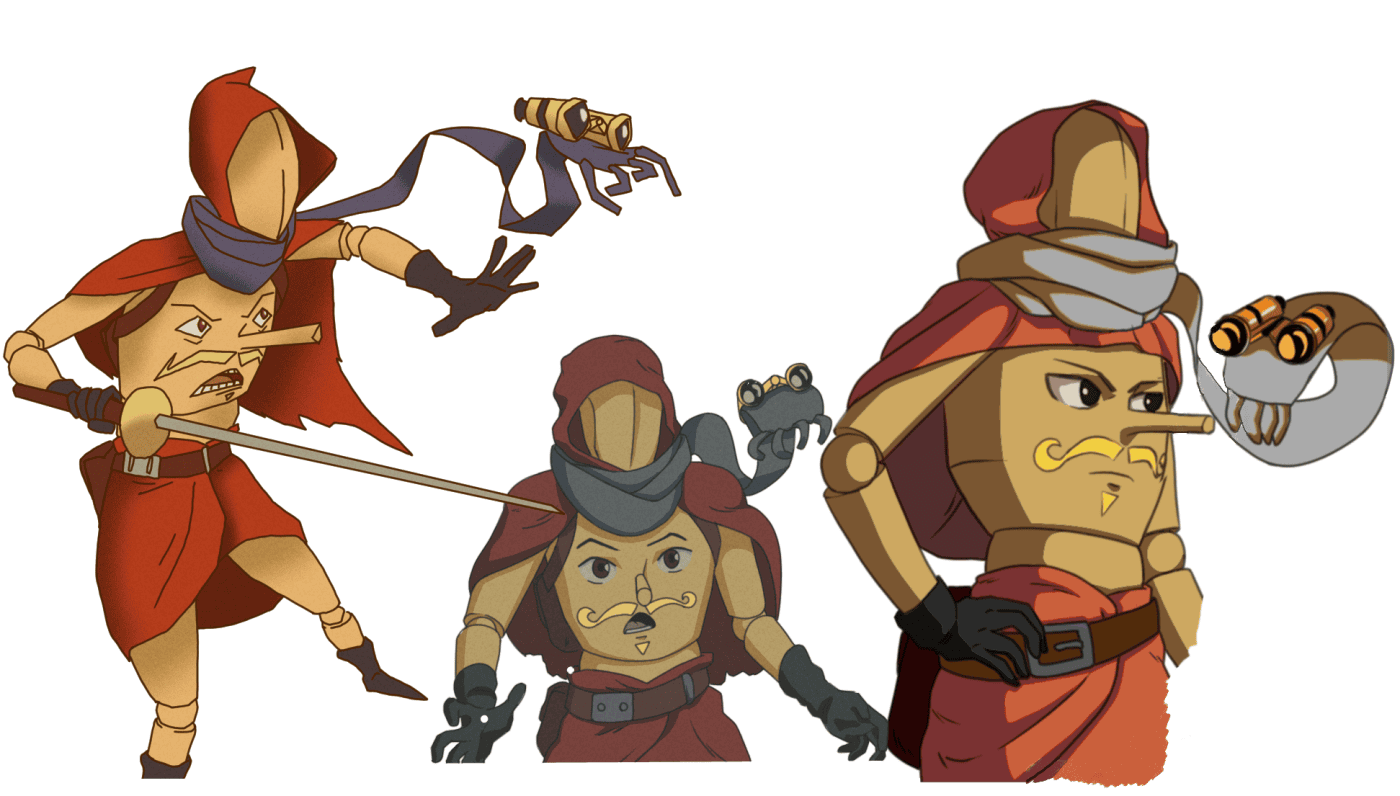
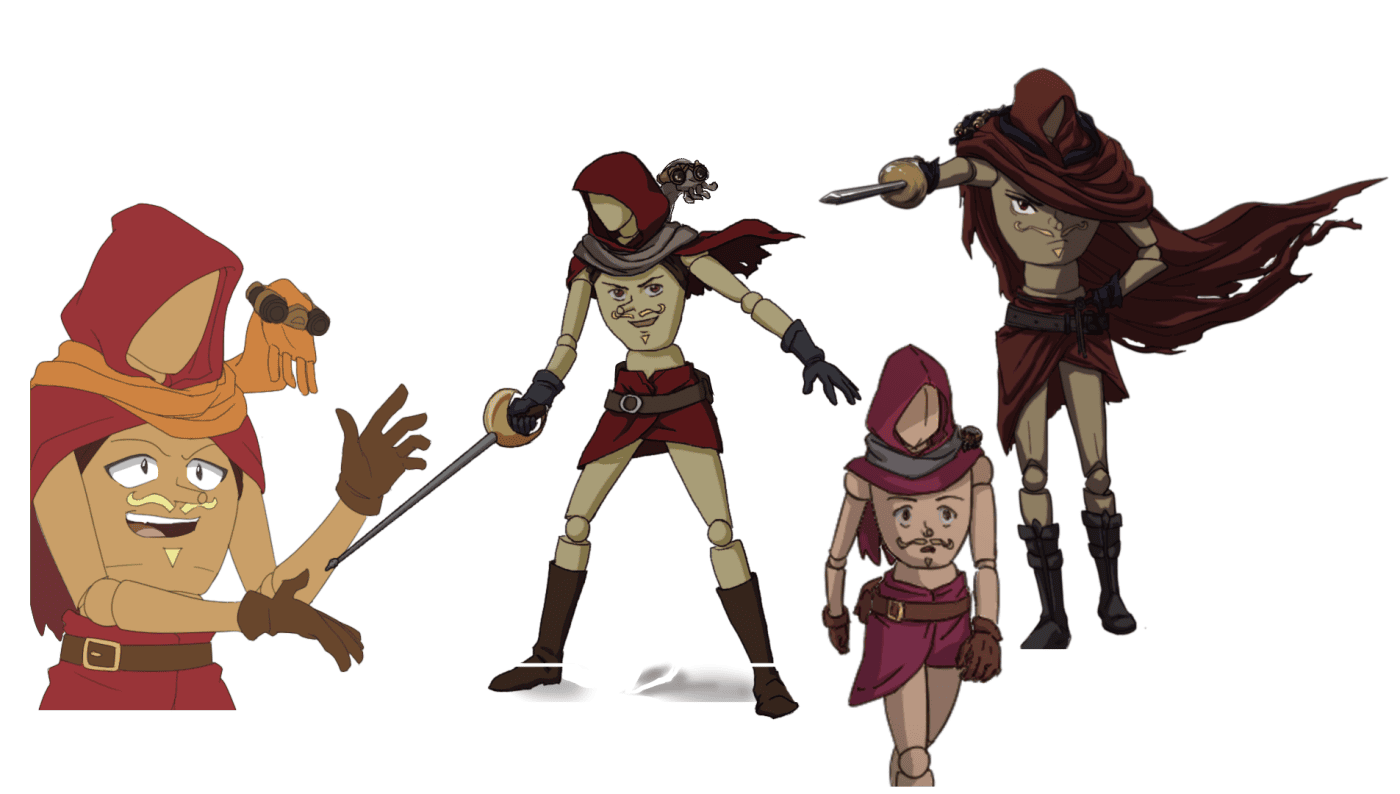
With Forgotlings, we also had to reinvent ourselves in order to accommodate much more outdoors gameplay in natural environments, compared to the largely industrial, urban city setting of Forgotton Anne. It took us a long time to realize how much it affected pipelines when a new technical approach was needed. This time around, we are making much more use of Unity’s spriteshapes to build the landscape versus large unique sprites. To achieve the same fidelity of detail and immersion, we had to create new tools and shaders to allow for this workflow. Kudos to our technical artist, Antonius, who’s become the project’s art director, for discovering the methods we needed to build the vast world in Forgotlings in an efficient way.
For this question, let’s play a little game: imagine we’re players with no prior knowledge—neither verbal nor visual—of Forgotton Anne, Forgotlings, or the Forgotten Lands. What are the key elements we must understand about this mystical and captivating world? How would you describe the expansive and vibrant realm around us, and how does Forgotlings intend to deepen and broaden it, enhancing its immersion and scope?
Alfred: In simpler terms to start with and hook you in: Imagine a place where everything that is lost and forgotten goes; old toys, letters, single socks. The Forgotten Lands is a magical world inhabited by forgotlings; creatures composed of mislaid objects longing to be remembered again and rediscover their purpose. Do you have a favorite toy from childhood—a cuddly teddy bear, a beloved doll? The Forgotten Lands is where it may have ended up! The hand-animated visuals and dark fairytale setting, with all these quirky charming characters brought to life, will soon have you feeling as though you’re living through a playable Studio Ghibli film. More deeply, it’s a world echoing our own, inhabited by strange sentient objects. It’s like you are in a vivid dream, in a world with its own rules you are trying to figure out, as you peel back layers of mysteries it’s wrapped in, hoping to discover some truth as to its origin and intention. Forgotlings lets you travel across this realm, familiar and mundane at times, utterly fantastical and surreal at other times.
One of the most impactful elements of Forgotton Anne was undoubtedly its powerful narrative—an emotionally resonant and deeply affecting story that built to a poignant crescendo, leaving a lasting impression on players. Naturally, this raises expectations for Forgotlings to deliver an equally compelling emotional experience. With that in mind, what new story awaits us in the Forgotten Lands? How did you approach the narrative design of Forgotlings, and what new themes are you aiming to explore in this next chapter set within the enigmatic and evocative world of the Forgotten Lands?
Alfred: In Forgotlings, players assume the role of Fig, a forgotling new spawn, from the moment he opens his eyes and awakens with sentience in the Forgotten Lands. He is soon afterwards thrust into the center of a plot that will have him take on a mission to unite the five forgotling tribes against a Beast prophesied to destroy the realm. We very much look forward to how players will respond to the story in Forgotlings—knowing that it differs somewhat in its storytelling style compared to Forgotton Anne.
It’s a sprawling epic this time around, held together by its main theme revolving around “purpose” and its connotations: How does our past inform the present and future, and what role do our beliefs have in shaping us and, in turn, society, as well as where are we headed? To which degree are we informed by free will vs. to which degree is an inevitable destiny awaiting us? And last but not least, how should we co-exist with differences and why should we choose to exist in the face of life’s harsh realities?
I know, it’s quite a mouthful of questions that philosophers throughout history have tackled with, and we don’t claim to have the answers to them. But it makes for an exciting story where the stakes become very personal. They are complex topics in a complex world and we’re trying to reflect that with our narrative design.
While we are aware that it may take a little longer to hook players emotionally in the story of Forgotlings versus Forgotton Anne, we believe we’re hitting an even higher emotional crescendo with this game by the time the story reaches its climax and conclusion.
Whereas Forgotton Anne worked aesthetically and mechanically with the concept of duality and binary, in Forgotlings “multiplicity” is the key to understanding the decisions behind a lot of its design. There are multiple tribes, multiple interactive pillars, multiple dialogue options, and multiple approaches for the player.


While Forgotton Anne primarily revolved around the character of Anne, it was clear that the true, often unseen protagonists were the forgotlings—sentient beings, lost and seeking their purpose, created by humans but forgotten over time. In the prequel, these forgotlings take center stage. For those unfamiliar with the magical world of the Forgotten Lands, could you offer a more detailed explanation of what the forgotlings are and what they symbolize? Furthermore, could they be regarded simply as objects, or do particular attributes and qualities distinguish them from ordinary forgotten items? What makes these sentient beings fundamentally different from abandoned objects?
Alfred: Forgotlings can be any object we’ve created as humans. In the creation process we imbue the object with purpose, its traits reflecting our taste and beliefs. The game’s premise and main concept we’d like players to buy into is that when these objects are forgotten, they spawn in the Forgotten Lands and awaken with sentience. They don’t always remember their past in the “Ether,” as we call the human world in-game. They just have this vague longing to be useful, their main aspiration being to recall their “true function”—their calling in life.
Now which object becomes a forgotling and which doesn’t? It’s something we touch upon in the game and it’s related to how much attachment it has had from their creator or owner. The more they served us and the more we treated them with care, the more anima they have in them—anima being the life force that animates them, bringing them to life. Now what happens in an industrial world where we mass-produce objects? Each thing is no longer hand-crafted and we no longer value things as much. Here the notions of consumerist society and mentality comes into play. This affects how much anima is inside of them and whether they can function as a forgotling or just a lifeless object.

The lives, expressions, and psychology of the forgotlings appear to subtly mirror human behavior, particularly our tendency to thoughtlessly discard objects, leaving them scattered, forgotten, and stripped of value or purpose. Could this serve as a central interpretive framework for understanding the forgotlings? Furthermore, if you’re open to sharing, have any personal experiences or autobiographical influences contributed to the creation of the forgotlings and the deeper meaning behind their concept?
Alfred: Yes, you’re right—ultimately the concept of forgotlings is a vehicle for us to explore the human condition in a fantasy world. Fantasy that sparks the imagination can provide us with a distance that grants us a new perspective on familiar topics and questions. Like metaphors, it can help us understand ourselves and the world better.
On a personal level, I think what drew me to forgotling creatures in the first place with my earliest sketches was the idea of forgotlings as manifestation of memories. In my own life, I have certain memories I revisit for different purposes, or sometimes involuntary. They might contain a lesson, might be a reminder of why I am where I am, or who I’ve become. Places, people, moments. But during the development of Forgotton Anne, I wanted the Forgotten Lands to also feel like a real place, up to a certain degree—instead of having the story being interpreted as all being a figment of someone’s imagination. This meant making forgotlings more one-to-one with objects left behind by humans. But the idea remains that they are animated by the memories we have with them.
Michael: Personally, as I use certain objects for longer periods of time, I tend to feel a sense of companionship with them. I want them to have as long a life as possible. Therefore, I can relate quite well to the concept of forgotlings and them having more anima based on how cherished they were.
Alfred: By the way, this time around we ran a Kickstarter crowdfunding campaign for the game and so we’re very happy to include forgotlings that have been real cherished objects by a group of backers!
One of the most captivating aspects we’ve been reflecting on is the distinctive choice of protagonist for the upcoming installment, which will see the baton passed from the young Enforcer Anne to Fig—an enigmatic, posing doll with a sharp awareness of social cues. Fig’s uniqueness lies not only in his appearance and role but also in his exceptional ability to retain fragmented memories of his past, a rare and fascinating trait among the forgotlings. With that in mind, we are eager to understand: what makes Fig the ideal protagonist for this new installment, among all the forgotlings in the Forgotten Lands? How does his character differ from the others, and in what ways will the gameplay and mechanics evolve when playing as Fig, compared to Anne?
Alfred: Fig is a much different character than Anne. Inherently good, he is adept at playing whatever role is expected from him, based on his past as a posing doll. That comes with its own character development arc, where he’ll have to deal with a different set of personal challenges. First and foremost, there is a difference between playing a role and becoming a character. Secondly, as a good-natured forgotling believing in justice, how do you navigate a complex world that’s seldom black and white? It’s what most of us face, I’d say, and therefore he is the perfect protagonist in a story exploring the themes we’re interested in with this game.
As for mechanics and how those reflect Fig’s growth: at each tribe, there’s something for Fig to learn, and a new move or knowledge to be acquired that he can use in combat or outside. Fig will be challenged physically and mentally—through the swordfighting capabilities afforded by his strength and agility, as well as through the need for nuanced emotional reasoning in a world of pluralities. He navigates a fractured world with many factions at play, which is much different to the position of influence that Anne has under the consolidated rule of Master Bonku.
With Forgotlings, while building on the same premise as Forgotton Anne, we zoom out—or in—and look at the first impulses in us humans that could lead us down the path of reliving past cycles or breaking free of them. This includes our search for meaning, to make sense of a complex world that is changing all the time, how we cope with that by forming tribes, by finding or building a home. We had this character Fig in Forgotton Anne, who is sort of like a Robin Hood rebel leader when players were introduced to him, and we thought that is the perfect vehicle for Forgotlings—to follow him from the very beginning to how a journey transforms him and the world around him.
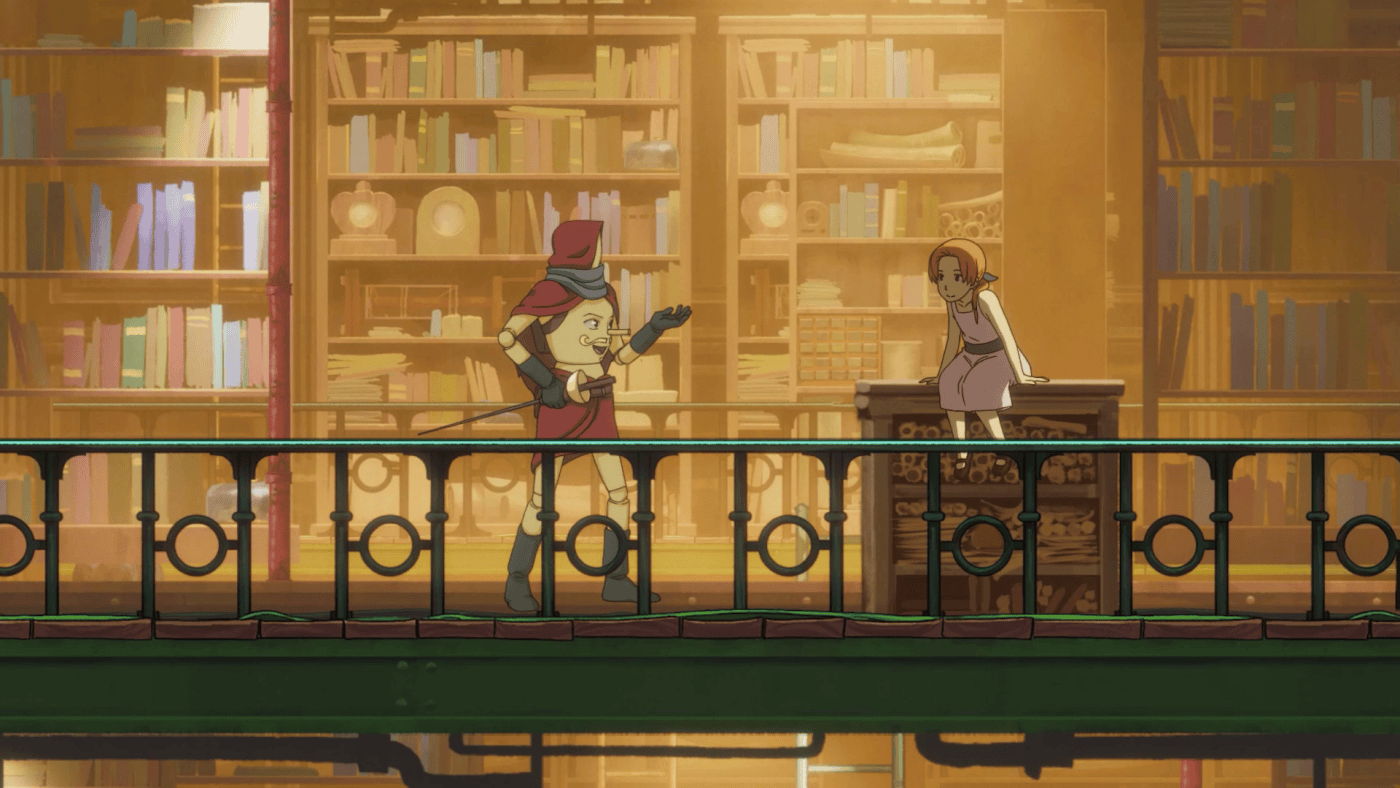
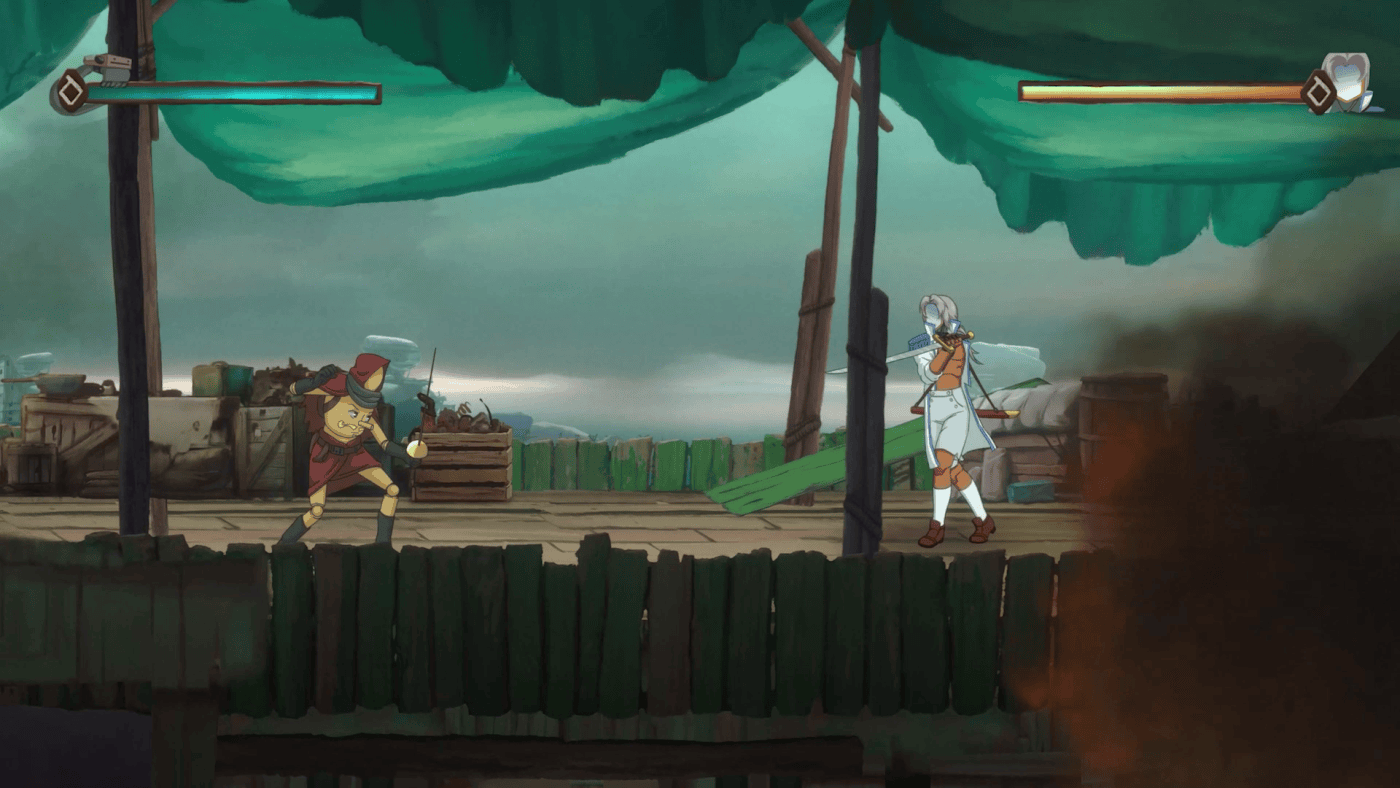
One of the most captivating features of Forgotlings is the new face of its game world: a sprawling, Metroidvania-esque semi-open world that Fig and his crew aboard the Volare will navigate. How is the open world structured, and how will exploration be managed throughout the game? What is the overarching creative vision behind the world-building and design of this vast realm, and how will players engage with both the world as a whole and its individual biomes and locations? Will the Volare serve purely as a means of transportation, connecting various regions of the world, or will it also act as a dynamic, interactive hub that players can engage with in meaningful ways?
Alfred: There is a stage in the game—during the second act, if you will—where the game opens up and provides players with the freedom to travel to where they please. There’ll certainly be a vast world to explore, with different tribes that players can visit and meet. Fig can pick up extra moves and special abilities at different locations and certain places will be conditionally locked, so it is a Metroidvania-lite experience in some aspects, I’d say.
We want players to really feel the “I’m going on an adventure” feel—the journey is a real physical journey not just a psychological one. “To Travel is to Live” as the Danish fairytale author H.C. Anderson says. We want players to live the adventure, and Volare, the sentient ship, is the mobile home of Fig and his crew. You’ll be able to add a few members to the crew along the way and the journey is enriched as they travel with you to the different locations, experiencing growth alongside you.
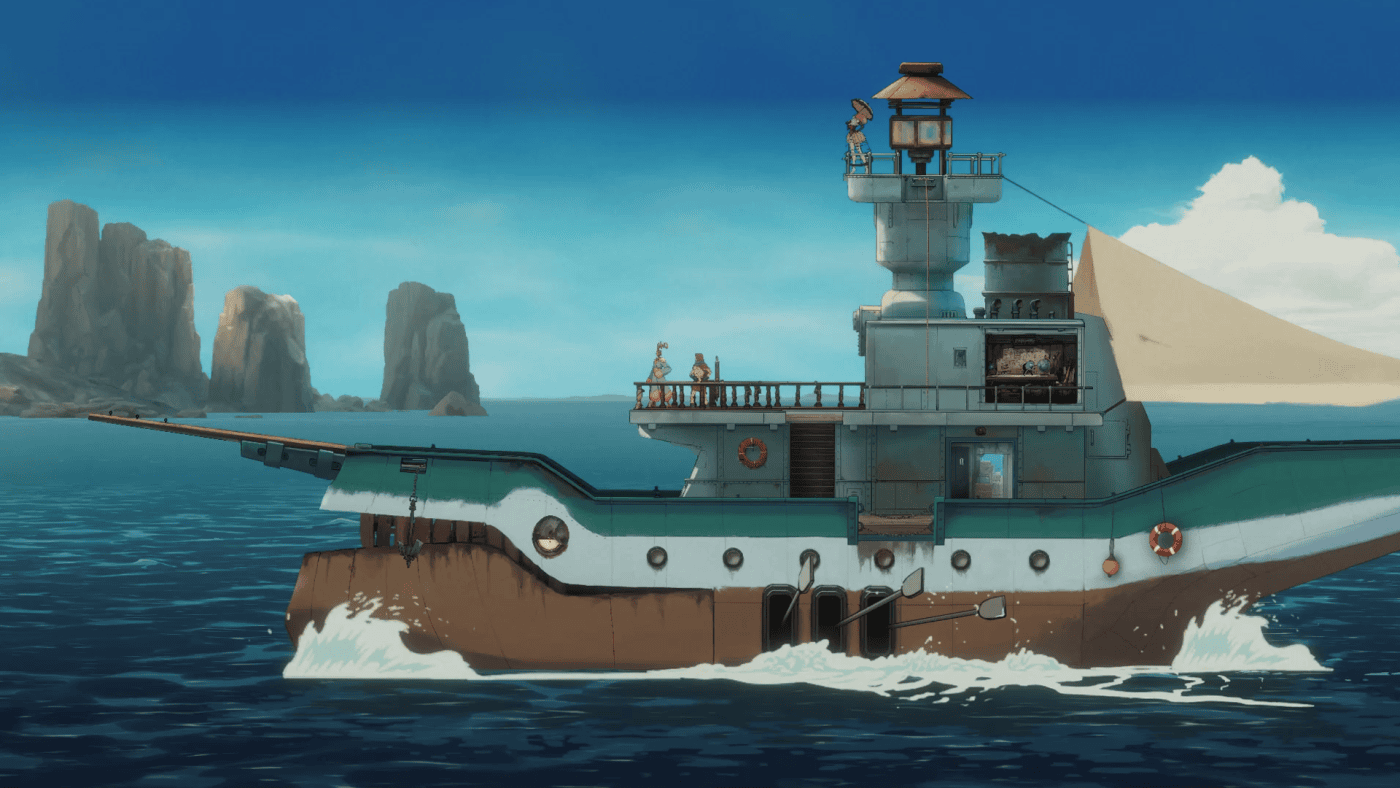
One of the most intriguing—and so far, most closely guarded—elements of Forgotlings is the crew that will accompany Fig on his journey through the Forgotten Lands: a diverse and motley group of forgotlings who board the Volare, joining the protagonist on his mission and offering their support, expertise, and companionship along the way. Aside from Silvia, very little has been revealed about the identities or roles of the other crew members. If you’re able to share, could you tell us more about the crew’s composition and the role they’ll play in the narrative? Will players be encouraged to actively build relationships and engage with each character, or will the crew remain by Fig’s side throughout the journey regardless of the player’s choices and interactions?
Alfred: We can understand the curiosity surrounding the other crew members! Well, I’d rather not spoil too much at this stage pre-release, but your crew can have an impact on the story and I hope players will find the interactions meaningful.
It is a motley crew as you described them and each one explores the game’s thematics from a different angle. Among others, there is a fashionable headless mannequin who’s always questioning your motives, a socially-awkward chess piece who’s the resident INA obsessive, a princess hat with an identity crisis interested in power structures and a broken drill who’s searching for a new purpose. The Volare and the crew is the game’s heart, providing intimate moments and continuity in an otherwise sprawling world and a plot with many strands.
The magical world of the Forgotten Lands is one steeped in mystery and wonder, where four cardinal energies flow through all things. It is a vast, pristine world governed by its own unique set of rules, traditions, cultures, and ideologies—an intricately balanced society sustained by five powerful tribal factions. Each tribe holds equal sway, coexisting in harmony without dominance or conflict, collectively upholding the delicate balance of the realm. Could you offer deeper insight into the lore, cultural identity, and traditions that shape the world of Forgotlings? Furthermore, could you provide a more comprehensive overview of the five tribal factions players will encounter throughout the game, delving into their distinctive traits, their roles within the narrative, and how each faction contributes to maintaining the order and harmony of this enchanted world?
Alfred: The plot in Forgotlings revolves around Fig travelling the Forgotten Lands to seek out the heads of the five forgotling tribes and get them to collaborate to come up with a solution against the Beast threatening the realm. The five forgotling tribes that Fig will get to know include the Sonavi, Servus, Videra, Aufero and Karus.
The Sonavi are entrepreneurial, quick to move and lately have been digging into the rocky edges of the realm with their mine project, extracting valuable crystals along the way. The Servus are compassionate and seek to protect themselves and the vulnerable, sheltering themselves on an island that has lately been breached by bandits. The Videra are the custodians of the past, preserving history in towers erected to store books and samples of everything. The Aufero are industrious and wield their influence through controlling the economy—they also produce Feros, the dominant currency in the realm. The Karus keep to themselves, more concerned with the immaterial and transcending forgotling existence.
The tribes used to gather annually at the center of the realm, the ancient site of Agora where the council of chiefs took place. When players enter the realm, however, this council has dissolved and in its place suspicion of one another has taken hold amongst the tribes. Fig must balance the interests of each and probe his own morality against the overall mission of winning the favor of all the tribes.
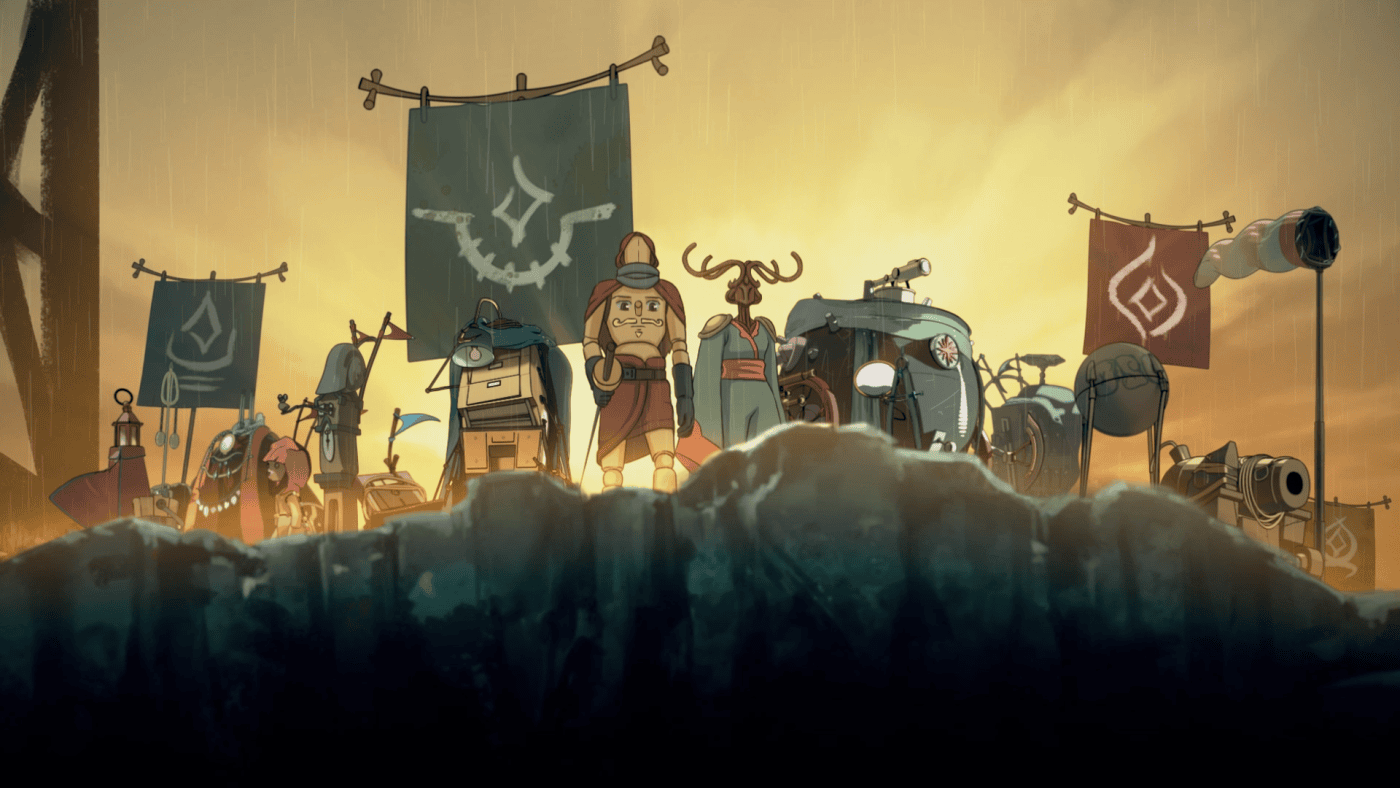
One of the most notable design choices in your approach to gameplay and interactions with the forgotlings and their tribes is the “Choice Wheel.” This unique feature offers players four distinct response options—Challenge, Encourage, Empathize, and Question—during encounters with the forgotlings. Could you delve deeper into how this system shapes the player’s interactions within the narrative? Furthermore, how do the decisions made through this mechanic influence the broader storyline and ultimately determine the fate of the forgotlings, based on the player’s specific dialogue choices?
Alfred: We dedicated a lot of time early on in development to explore ways to gamify dialogue choices. I think in the end, we’ve arrived at a simpler version than we initially strove for, but I want players to discover the impact of choices themselves and our twist on it. One of the directives we followed early on is that “Fig is not a dick”—or, in more polite terms, “Fig is not a jerk!”— meaning that Fig is, at his core, good-natured. In Forgotlings, we are not interested in presenting players with the choice to turn Fig into an evil character versus good character. Fig is good-natured and always striving to be helpful—period. As most of us are. But that doesn’t make things less complicated or interesting, as we know from our own lives.
The question is: what CAN you affect and what is the best choice to make to achieve outcomes you desire? For this, we lean onto psychology, and so—without giving too much away—we’ve tried to somehow mimic this reality with our approach, through exploring those response options that you bring up. I think I’ve said enough and players will come to understand what I mean when they play the game! 🙂

One of the most immersive ways to engage with the forgotlings is through the captivating and strategic game of INA, which is the most popular pastime in their world. Could you provide further insights into the rules and distinctive features of INA? How does taking part in INA duels with NPCs contribute to fostering deeper, more meaningful relationships with the forgotlings? Furthermore, aside from INA, will additional mini-games be available to provide players with a refreshing break between missions?
Alfred: INA is a boardgame, played by two on a 5×5 board. Players have a deck of eight stones, each prepared prior, and they take turns drawing out stones and placing them on the board in order to capture Squares and win the game. It’s a relatively simple game inspired by classic games like Go and Chess, with the twist being the deck of stones that players can experiment with, by combining Power Stones that represent the five tribes in the game.
Far from being just a fun mini-game, its inclusion in Forgotlings is important for us and the game’s narrative design. Making and playing games has been a part of human activity throughout history—and right now with this interview we are taking games quite seriously, haha! But it is a natural extension of being human to make and enjoy games, as they reflect our desire and instinct to make sense of the world. It transcends borders in Forgotlings, as all tribes and forgotlings can enjoy INA with each other even if they may despise each other outside the boardgame. Engaging with INA is mostly optional, but there is a good payoff if players decide to pursue that track, as there are also INA tournaments in Forgotlings that they will be able to enter. Across the Forgotten Lands, they can play against many different forgotlings who have different INA playstyles, which adds a lot of challenge and room for strategization. As you play, you’ll find that some forgotlings are more cautious and defensive in their approach, while others are more aggressive. Due to resource constraints, we’ve had to cut more mini-games that we had planned early in development, but INA was and is a feature we’re very fond of and hope players will enjoy.
Towards the later stages in our Steam demo of Forgotlings, players also can try out INA themselves if they find Glass, the telescope forgotling, in his little hideout.
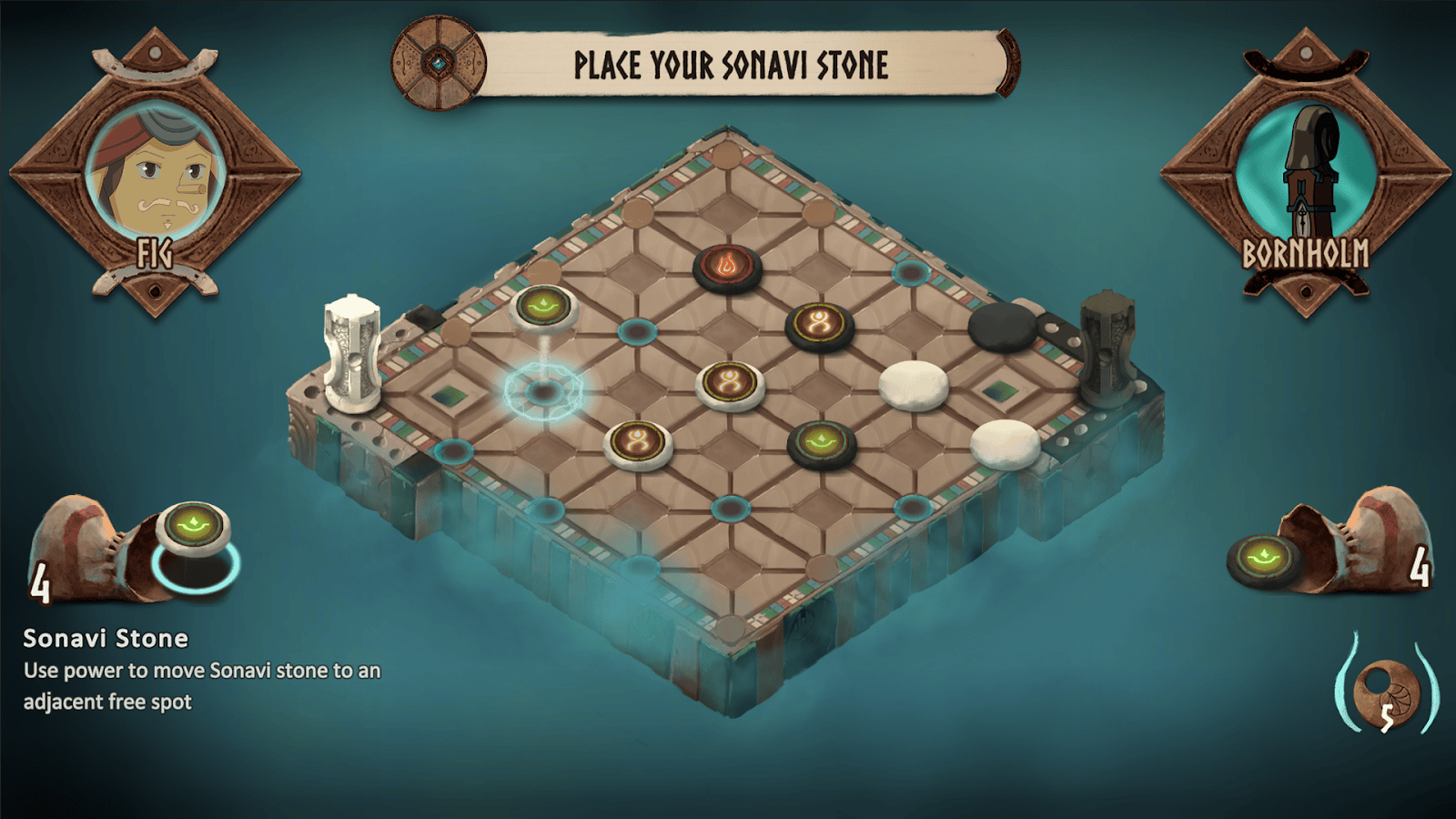
As a final question about the gameplay of Forgotlings, we’d like to shift our focus to the four core pillars that define its design philosophy: combat, platforming and exploration, narrative and dialogue choices, and INA. These elements are clearly designed to introduce greater depth, nuance, and complexity, building upon the strong foundation laid by the already acclaimed Forgotton Anne. How did you approach the development of these components to refine the overall gameplay experience—particularly in areas where Forgotton Anne, despite its strong puzzle design and core gameplay concept, may have felt somewhat limited in scope? Could you walk us through how you tackled each of these four pillars individually, and how you ultimately managed to integrate and unify them into a cohesive and engaging whole?
Alfred: We definitely want a broader audience for Forgotlings than with Forgotton Anne’s focus on puzzle-platforming. It connects with a theme in Forgotlings revolving around dealing with diversity—a world with different tribes, but also acknowledging people and players as multidimensional. To that end, we wanted to challenge the player and main character Fig in different ways, through combat, physical platforming, as well as emotional and analytical thinking.
In that way, it has almost felt like making four different games and throughout much of development we divided the game into four tracks and measured progress on those separately.
For the control of the main character, we wanted to improve the feeling that players had controlling Anne in Forgotton Anne. In Forgotlings, we wanted to make the movement snappier and perceived as less sluggish, while balancing that with our continued wish to make characters move in a grounded way expressed with hand-drawn 2D animation.
Michael: In Forgotton Anne, we placed a strong emphasis on the game’s cinematic feel and ensuring that Anne’s movements were as naturalistic as possible. Since we were working with frame-based 2D animations, we couldn’t simply blend between movements, and abrupt cuts would disrupt the cinematic look and appear glitchy. To maintain fluidity, numerous transition frames were drawn—kudos to our talented animators, Debbie and Sebastian, for their hard work.
Additionally, we implemented a custom system that allows animations to transition at the most natural frames during gameplay, ensuring a smooth and polished look. However, this also added more “weight” to Anne’s movements. Narratively, it made sense since Anne is human, but naturally, it also had consequences for the controls. In Forgotlings, things are different. Fig is a doll and therefore not bound by normal human constraints. This gives us more flexibility to create an improved and snappier movement style without it appearing unnatural. However, as Alfred mentions, we still aim to strike a delicate balance between snappiness and visual fluidity since our vision is to have a beautiful cinematic experience.
Balance is generally a key concept, especially when addressing the combat pillar. We wanted the game to appeal to a broader audience while ensuring that our original Forgotton Anne player base wouldn’t feel alienated by a vastly different and more challenging experience. To achieve this, we’re offering a “story” difficulty mode, where enemies present only a slight challenge.


When discussing music and soundscapes, we’re not just referring to a purely auditory dimension, but rather to a holistic sensory experience that captivates all the senses, communicates underlying themes, evokes deep emotions, and transports us to an entirely new world. This, at least, has been our experience with the sound design and OST of Forgotton Anne—a truly exceptional work, created in collaboration with the Copenhagen Philharmonic Orchestra. The experience in Forgotlings seems no less impressive; it seems you’ve elevated the already outstanding work from the first installment with a distinctive OST, produced in partnership with the Theatre of Voices choir. What can we expect from the Forgotlings soundtrack? What sounds, tones, and themes will it explore to express the poignant story of the forgotlings?
Alfred: Music is definitely a big part of the experience always, as it contributes very strongly to the cinematic feel. Peter Due, our composer, is a long-time collaborator and so it is just a joy to explore and discover the new soundscape of a project. With Forgotlings, we knew early on we needed a human touch to the score, as the main characters and creatures of the game are objects that we are not anthropomorphizing to the same degree as, let’s say, Disney. While humans are almost nowhere to be seen, it is ultimately about humanity. The scope of Forgotlings is much bigger than Forgotton Anne so we’ve worked a lot with the themes and style of composition for each forgotling tribe in the game in particular. Theatre of Voices are amazing and it really captures what we were going for—with just a few singers, we can express something very intimate or something very epic with the human voice as the throughline. This way, we are able to incorporate human elements via the score, so the human touch and human presence is always there, in some way, even if it’s not directly seen.
So we went about identifying a number of themes in the game, whether it was related to a tribe, a prophecy, certain characters or the spirit of adventure, and Peter came up with leitmotifs or musical themes for each. It could, for example, be the case with the Videra tribe, whose nature of intellectual inquiry is reflected in their theme through mathematical musical patterns, like those heard in Bach’s music. Another such compositional trait is also apparent for the theme of the Sonavi tribe, which traverses many intervals spanning across a lot of distance, yet never quite fully lands or closes musically—reflecting that tribe’s inclination for exploration and embarking on projects that never finish.
The main musical theme of the game perfectly expresses the game’s innermost beating heart—an ode to our human spirit capable of overcoming challenges against the odds, rising above melancholy to instill hope and ultimately uplift.
The release of Forgotlings was recently pushed back to Fall 2025, and fans will be curious to learn more about the factors that influenced this decision. Could you shed some light on the reasoning behind the delay, and how do you see this extra development time contributing to the overall quality and vision of the game?
Alfred: Forgotlings is our most ambitious project to date and I think it is often easy to forget that we are a very small team. The scope, compared to Forgotton Anne, is two or three times bigger, with many more features and a lot more environmental diversity. For context, Forgotton Anne takes about 6 hours to play through, while Forgotlings has at least 10 hours of gameplay, with many more hours if you explore through everything. We really wanted to stick to our initial release date, but as time went on, it became apparent we need the extra time to give the game the polish it deserves. We really hope all will be forgiven and understood once players get their hands on it.
At this stage, how close are you to completing the final stages of development? Could you provide an update on the progress of the game leading up to launch, and share your thoughts and emotions as you approach this pivotal milestone? Lastly, if we may ask on behalf of the console players: do you have a planned release window for the console versions?
Alfred: We are incredibly excited to launch the game soon. It is always a tumultuous last sprint finalizing a game, especially for games like Forgotlings and Forgotton Anne, as so much of the final experience depends on the coming together of many elements—many which are not finalized until the last stage, while trusting a vision and approximations in many instances. I think we are so deeply immersed in the project so while we do feel some emotions when thinking of a release, a lot of it is suppressed by the more urgent matter of polishing the game.
Michael: The final stages can feel like being on a boat in a stormy sea—we must navigate the wild waters to reach shore. But once the storm calms, we can finally step onto land and see how far we have come.
Alfred: Be sure to ask us again post-release, and I think we’ll be in a better head-space to reflect on this period. Not that it’s a wrap when we release the game, as there is always followup things to do, with ports and patches and additional languages support among other things. But we aim to have the game out on consoles within this same year definitely.
We hope that many of the things that excited and moved us in this project, from gameplay to story, will also be felt by gamers around the world as well.
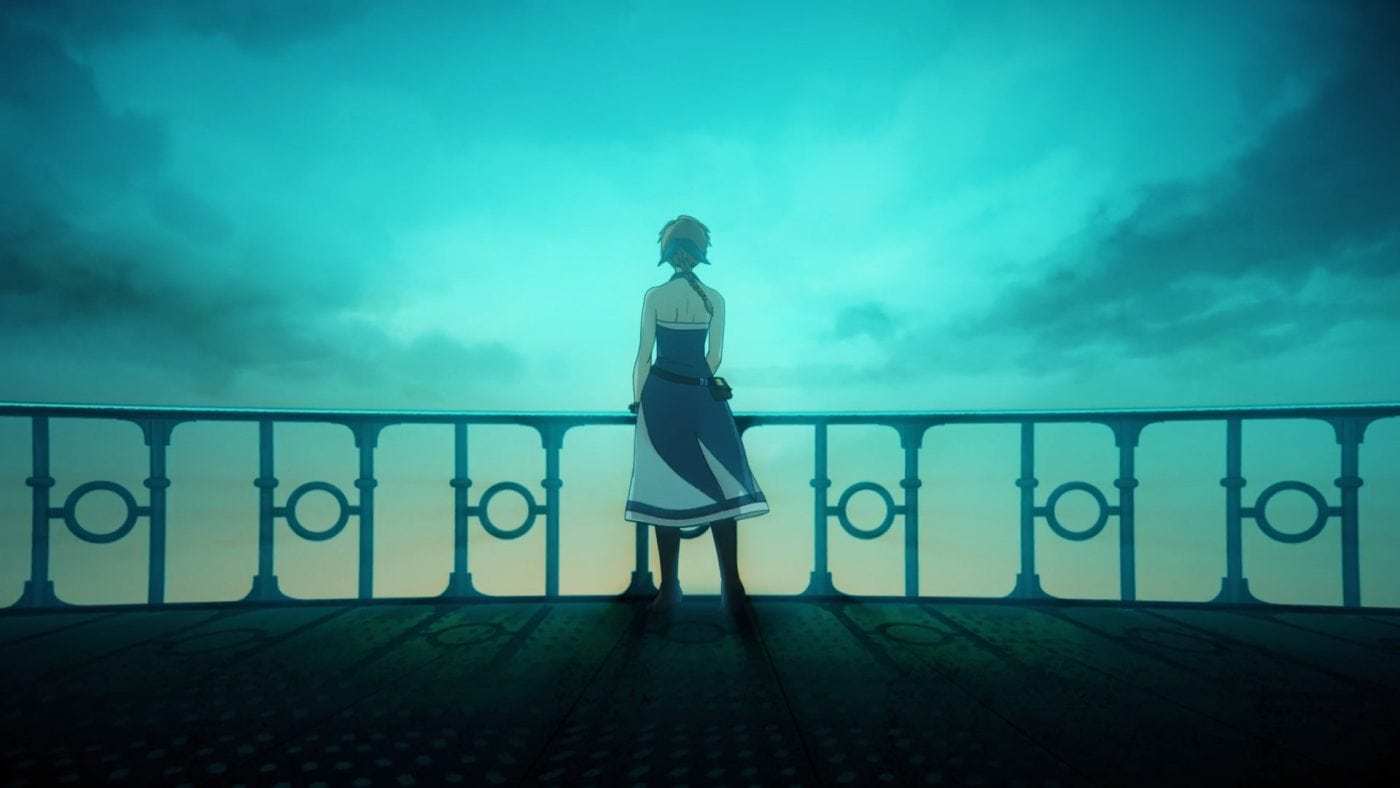
The sentient ship Volare is almost ready to set sail from the shore… Will you join Fig’s crew on their epic, winding journey?
With Alfred and Michael’s response to our final question, we draw the curtain on our special deep dive into Forgotlings—a journey we hope has provided you with meaningful and insightful glimpses into Throughline Games’ highly anticipated title. As always, we extend our warmest thanks to you, our readers, for joining us and allowing us to guide you through this exclusive feature. Our deepest gratitude also goes to Alfred Nguyen, Michael Godlowski-Maryniak, and Community Manager Tracey Le for their time, openness, and for making this interview possible.
As mentioned during our interview—and recently confirmed via the development team’s official channels—the PC release of Forgotlings, originally planned for June 12th, has now been rescheduled for Fall 2025.
While we await further updates from the team at Throughline Games, stay tuned with us and be sure to follow the developers via their official website and social platforms—including their X account and Discord server—to stay up to date on the latest developments surrounding their upcoming project.
That’s all for today. Until next time!

